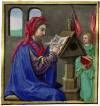
It was well worth seeing, and if there are still indulgences to be obtained from viewing relics of the saints, then I must have gained a few more years off purgatory.
The reliquaries were mostly magnificent, and the exhibition was well laid out, taking you on a time-line from early Roman memorials through to the Reformation and beyond. There were numerous rock-crystal containers and gems each holding from one to several relics, some of which it was reasonable to suppose that they were the genuine article, such as skull fragments from Thomas Becket, as history records that such mementos were taken by the monks before his burial. Others though needed faith strong enough to move mountains, such as a hair from the Virgin Mary (her head, one is led to believe) or a shred of Christ's umbilical cord. And there were enough fragments of the True Cross to construct a small matchbox, as well as several thorns from the crown of thorns.
The same day was highly educational, for not only did I see this exhibition but I also called in at the Sir John Soane Museum in Lincoln Inn Fields.

This Regency collector was a hoarder of all things architectural, and the three adjoining houses in the square flow into each other in a warren of rooms filled with cornices and carvings.

In his Picture Room the wall panels are hinged so that more paintings can be displayed behind, and hidden from sight are two series of Hogarth oils, "An Election" and the better-known "Rake's Progress".

On the end wall are three paintings by Canaletto who must be one of my favourite artists, and it was a treat to be able to get up so close to the main picture of St. Mark's Square in Venice and see exactly how he created his figures with just small blobs of colours.
It's a truly unique place, but Soane must have been hell to live with. Perhaps it's no surprise that neither of his sons grew up to be supportive of his mania.
I also made another trip to the Victoria & Albert Museum to look at their new gallery of religious architecture and altar pieces. There are some magnificent examples here, and I was able to freely use my camera.




Then as I waited for my train at Liverpool Street Station I was reminded that there was an important event taking place in just a few short hours ...






Oh, I love the Soanes Museum! I actually touched the Sarcophagus downstairs. I think it was Seti I's. I always tell friends who are going to London, that they should go. It's fascinating!!
ReplyDeleteI feel cultured just knowing you.
ReplyDeleteYou've hit two of my my all time favorite spots - Soane & V & A - and caught the BM relics exhibition, which I've been pining for since I first read about (is there a catalogue?). Used to stop by the Soane in the late 60's, when it was little-known and was normally empty of visitors. And entry was free to it and the V & A. Thanks for the memories.
ReplyDeleteThere was a very basic free Guide to the BM exhibition, but no illustrated catalogue as such. There is an accompanying book which is lavishly illustrated, and that's a mere £45. I didn't buy a copy.
ReplyDeleteThe John Soane Museum is still free, as is the V&A. The Soane asks for donations, and I bought their short guide for £2. They are keeping it like a private house, and you still have to sign their Visitor's Book when you go in. (The sarcophagus of Seti I is now enclosed in a large glass box to keep greasy-fingered tourists from touching it!)
The V&A also remains free entry, though they have large signs inviting donations.
Oh, I barely touched it, and my fingers weren't greasy! If I'm being honest, I didn't recognize it for whose it was(it wasn't even labeled in 1997!) until after I came upstairs and ran into a "docent" who was telling us how the houses were connected and how it came to be there in the first place.
ReplyDelete